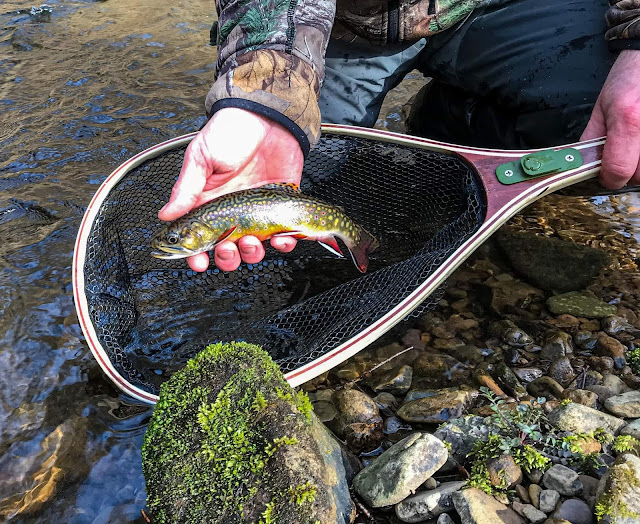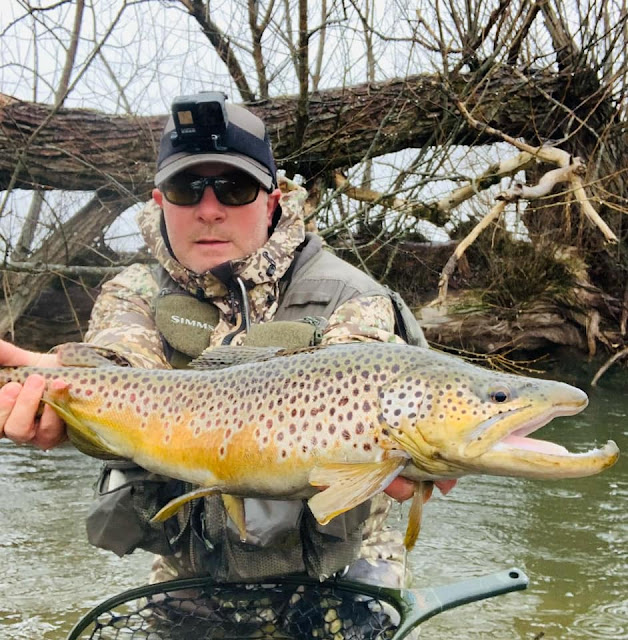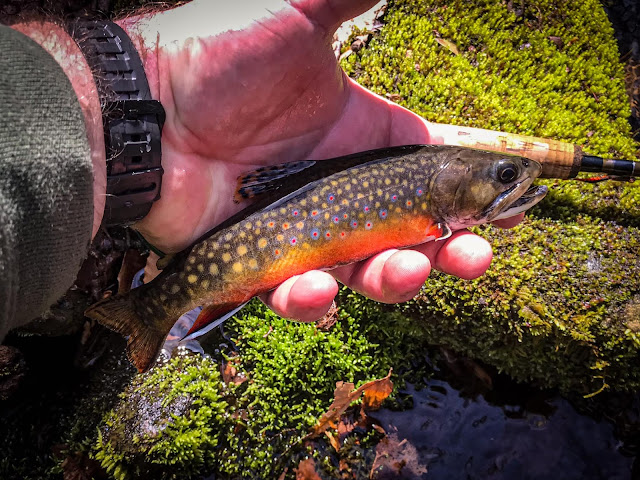With the closing of stocked trout waters in Pennsylvania coming soon, many anglers will be getting the itch to go trout fishing. Spring is right around the corner and the rising temperatures match many anglers' rising desire to hit the water to go trout fishing. Special regulation areas and DHALO areas will see more activity than in the last four to six months. This time of year, also means the most pressure that Class A Wild Trout Waters will receive all year. Being an avid brookie chaser, this time of year scares me to no end. I decided to use this fear to fuel this article. I want to share what I feel are the responsibilities that an angler must take on when deciding to target wild trout. These precautions should be considered when fishing for all trout, but the future of wild trout fishing depends on the actions we take today.
 |
| My good friend and fishing partner, Jeremy Troutman, shows the proper way to navigate a native brook trout stream when the eggs and fry are still in the stream bed. |
 |
| A gorgeous wild brown that I had just picked out of the water for a photo. At the sound of the photo capture the fish was placed back into the net. |
Barbless hooks are a must when fishing for wild trout. Barbless hooks penetrate the fish better and take very little effort to remove, regardless of what is on that hook. Barbless hooks are vitally important if fishing with bait or scented plastics. These types of bait have a taste and fish will attempt to swallow these offerings. You can greatly increase the odds of a fish surviving a hook removal with a barbless hook compared to a barbed hook. If fishing store bought flies or spinners, take the time to pinch your barbs flat before you fish. You can always purchase a hook file to sharpen where you pinched the barb. Your goal should be to cause the least amount of damage to the fish as possible, and barbless hooks are the best way to accomplish this goal.
 |
| Notice how calm this fish is. The fish is completely wet, laying on its side in my wet hands. This wild tiger was in a state of tonic immobility. |
 |
| A wild rainbow trout from a tiny stream. If this stream was broadcasted on social media it would sure to receive a large increase in pressure due to the rarity of wild rainbow trout in Pennsylvania. |
The last topic I want to cover is over pressuring a stream. Pennsylvania is second only to Alaska for miles off streams or rivers. There are plenty of wild trout streams to target. I want to caution anglers from hitting the same small trout water more than a few times a year. If you do target the same small water within the year, space these trips out with a few months between them. You will enjoy finding new water, and not over pressure a stream. Even if you only have one wild trout stream in your area, your are far better off taking a trip to find new water than burning out your local stream. If you do have a successful day on the water, it is wise not to broadcast the stream names on social media or other internet forums. Doing so will bring added pressure to these small streams, and some of that pressure may come from anglers who do not know about the responsibilities listed above. I have seen some of my favorite trout wild trout streams become barren after the spot was announced to the masses.
 |
| My ten year old son admiring the beauty of his first wild brown trout caught on a fly he tied himself. |
I don’t want this article to come off as a lecture, but I care deeply for the future of wild trout. It is vitally important that we as anglers do our best to take care of these wild trout so they are around for future generations of anglers. I did not mention catch and release but I hope most anglers would practice the catch and release of wild trout. There are plenty of hold over and stocked fish to take home. I hope to be able to educate as many anglers as I can about these responsibilities and hope that they also pass on this information. This article in not about greed or claiming these wild trout as my own, but is intended shed light to anglers who may not even realize they are doing anything that may harm these fish. I would love for the mindset and education of many anglers to grow, as well as their love and understanding of wild trout. The biggest point I hope to point out in this article is that there is no stock truck out there to replace any of these fish, so please read and learn from the responsibilities I list above if you do not already do so. Tight lines and best of luck in your adventures.






































